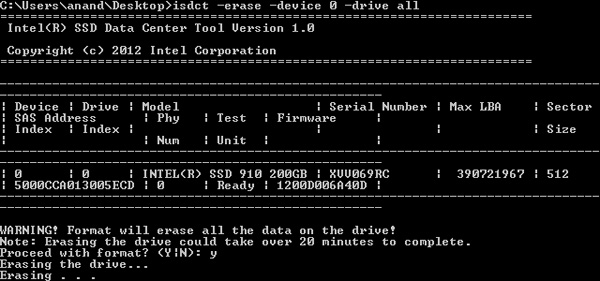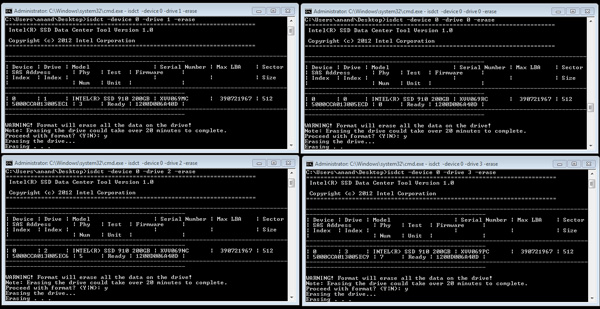The Intel SSD 910 Review
by Anand Lal Shimpi on August 9, 2012 1:00 PM EST- Posted in
- Storage
- SSDs
- Intel
- Intel SSD 910
Intel's SSD Data Center Tool
Despite Intel's wonderful desktop SSD toolbox, there's a more powerful but less user friendly option for the 910. It's called the Intel SSD Data Center Tool (isdct for short) and it's driven entirely by the command line. The tool is available for both Windows and Linux. You can use the isdct to secure erase the 910:
Each controller/partition must be secure erased independently, or in tandem by running four copies of isdct:
Since each partition is effectively an independent drive, you can run multiple isdct commands and just target a different drive with each instance. The isdct is also how you monitor temperatures on the individual drives, once again you have to execute a command per drive to get the temperature of that drive. Under Windows you need to execute the following command:
isdct.exe –log 0x2F –drive <drivenum> -device <devicenum> -verbose
Then look at the value of byte 10, which will tell you the current temperature...in hex. Convert back to decimal and you'll have the temperature of the specified NAND partition in degrees C. I have to admit I found all of this a bit endearing (I never get to read temperatures in hex), but your system administrator may be less impressed. Thankfully it shouldn't be all that difficult to script the isdct to quickly give you the data you want, even at regular intervals. The tool exposes quite a bit and since it's entirely command line driven it's pretty easy to automate, but I can't help feel like Intel should at least do some of this for you. I appreciate the flexibility, but others may want something a bit simpler.
Other than obsessively monitoring temperatures (I never saw a temperature higher than 1F, 37 is the operational limit) and secure erasing the drives, I used the isdct to switch between performance modes on the 910:
Remember the 400GB drive always runs in this max performance mode, but the 800GB drive must be forced into it. You get a warning about the increased cooling and power requirements (up from 25W max TDP and 200 LFM cooling requirement) but otherwise the process is painless.













39 Comments
View All Comments
lorribot - Thursday, August 9, 2012 - link
I like the idea but coming from a highly redundant arrays point of view how do you set this all up in a a safe and secure way, what are the points of failure? what happens if you lose the bridge chip, is all your data dead and buried?Would you be looking to put say 3 of these cards in a server and software raid 5 across the cards for multiple disks?
No hardware raid solution will work across multiple PCI-e cards so there really needs to be some work in how to manage all this in a sensible way needs to be done.
I doubt any one in an Enterprise would stick one of these in a server and use it as primary storage for their SAP database it is way too risky a proposition.
What would be good is a 3 1/5 format drive with a fibre channel interface that could work in existing storage solutions.
FunBunny2 - Thursday, August 9, 2012 - link
-- What would be good is a 3 1/5 format drive with a fibre channel interface that could work in existing storage solutions.If memory serves, that's what STEC made and hasn't been all that profitable.
Guspaz - Thursday, August 9, 2012 - link
At the end of the first page, "performnace"happycamperjack - Thursday, August 9, 2012 - link
Wouldn't it be more fair to compare it to a 800 gb CM88 R4 since it's around the same capacity and price as the intel 910 and quite a bit faster.Elixer - Thursday, August 9, 2012 - link
What happens when it is over 60% full on these things ? I am betting a huge drop off in speed, just like the desktop parts.MrSpadge - Sunday, August 12, 2012 - link
Probably not, since they're >50% overprovisioned.Jammrock - Thursday, August 9, 2012 - link
I would like to see some Fusion-IO tests. They are generally considered the highest end in enterprise SSDs. I've played with some in the past and they were crazy fast and reliable.puffpio - Friday, August 10, 2012 - link
agreed..any thoughts on a heads up between this and a similar capacity fusion io iodrive2?happycamperjack - Friday, August 10, 2012 - link
http://hothardware.com/Reviews/Intel-SSD-910-PCI-E...hmmmmmm - Saturday, August 11, 2012 - link
unfortunately, they are comparing the 910 to a 2009, discontinued card from fusion-io. would like to see a new card in the comparison to be able to compare what's on the market today